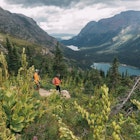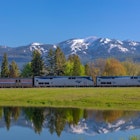
Experience Yellowstone National Park sustainably: your guide to going green

Sep 24, 2021 • 5 min read

Yellowstone is one of the most popular national parks in the United States – but sustainability is key to balancing visitorship with conservatorship © Abigail Marie / Shutterstock
Yellowstone National Park is the United States’ second most popular national park, with more than four million visitors a year – up a whopping 35 percent over the last decade alone.
Squeezed between record demand and a multi-billion dollar budget backlog, the National Park Service is facing some tough questions over Yellowstone’s sustainability. Some are even muttering if visitation continues to skyrocket, a daily cap on vehicles entering the park might one day be necessary.

In response, Yellowstone National Park and its main concessionaire, Yellowstone National Park Lodges, have made great strides in recent years to steer Yellowstone’s mass visitation towards a sustainable footing. You can do your bit by supporting the following projects. You might even save a few bucks in the process.
The complete guide to Yellowstone National Park
Food & Drink
Feeding Yellowstone’s visitors is a mammoth task that creates mammoth waste. The park’s concessionaire is doing its part by keeping 63% of waste out of landfills through aggressive recycling programs and composting. It also works with Montana’s Western Sustainability Exchange to link with local farms and food producers to supply the majority of its restaurant food. Eat, drink and be sustainable with the following programs:

Drink local craft beer: Let’s start with the easy one. All empty beer bottles can be recycled in park bins, where they eventually may make their way to into furniture throughout the park. In recent years, Yellowstone has partnered with GeoMATRIX out of Bozeman, Montana to create benches, picnic tables, bathroom vanities, window sills and countertops from recycled glass and fly ash.
Reusable coffee cups: Buy a cool Yellowstone coffee cup and you get a quarter off any coffee (fair-trade available) in the park’s restaurants and cafeterias. After a week you’ve earned your money back and saved half a dozen paper cups.
Compostable cutlery: Plastic knives and forks in the park’s restaurants are biodegradable, as are the to-go boxes, napkins and cups – so put them in the compost rather than the trash.
Drink wine: Another easy one. Several bars in the park now offer wine on tap; a more sustainable way of packaging and transporting wine. But no, you still can’t order it by the pint...
Eat local: More than 60 percent of the park menu items are now sourced from local or organic sources, from organic Montana lamb and grass-fed bison and locally distilled Wyoming spirits. Locally sourced produce means a smaller transport footprint, fresher food and healthier communities. The green leaf on park menus highlights sustainable options and details the local producers. Vegan options like lentil dal and portobello wraps offer the lowest carbon footprint.
The War on Waste: Recycling and Resources
Record numbers of visitors means record resources consumed – including more than 1700 rolls of toilet paper per day alone! Yellowstone National Park Lodges projects range from the big (the new Canyon Lodges are LEED certified) to the tiny (cutting back on plastic wrapping on its cute bear-shaped soaps), but everything helps. Meanwhile, light fixtures in the park are slowly being replaced with low-wattage fixtures that direct light only downward, saving energy and boosting dark-sky views.
Even in winter, when much of Yellowstone is shut down except for the Old Faithful Snow Lodge, Mammoth Hot Springs Hotel and Canyon Yurt Camp, the snow coaches run by Yellowstone Park Lodges are a new, semi-customized fleet that runs cleaner and quieter than the old models with mat tracks that look like they belong on a tank. The new fat-tire style coaches use three times less fuel and are 14 decibels quieter, too.

Softer footprint: Save yourself $5 a day on your park accommodation room rates by foregoing housekeeping when staying for more than one night. Around half of the guests currently participate, saving 300,000 gallons of water and 150,000 kWh of electricity annually.
Less waste: Several park restaurants offer smaller portions for a reduced fee in an effort to minimize waste. Straws are only supplied on request.
Bring your own water bottle: Yellowstone National Park Lodges no longer sells disposable plastic bottles of water. Dozens of water stations have been set up around park infrastructure, so filling up is easy. If you have to buy water, then easy-to-recycle, aluminum canned water is available.
Recycle bear spray and propane canisters: Anyone hiking in Yellowstone’s backcountry should carry bear spray, but most are never deployed and you can’t take them on a flight back home. The solution: take your bear spray to any backcountry office or to Bozeman airport. Drop your propane gas canisters at any park campground.
Shorter Showers: If every Yellowstone guest limited their shower to five minutes, the park would save 3 million gallons of water annually. This is important because climate change is already having a noticeable long-term effect on snowpack levels in Yellowstone, with 30 fewer days with snow on the ground per year, and 60 to 80 fewer days below freezing, compared to 50 years ago.
Electric vehicles: Don’t be intimidated by those Wyoming pickups, bring your electric car. There are now charging stations at Mammoth, Canyon, Old Faithful Lodge, Lake Hotel, Grant Village (under construction) and the Yellowstone Forever store in Gardiner, plus the gateway communities of West Yellowstone, Jackson and Cody, so you are never far from a charge.

Bonus: Go fishing
Being a sustainable park visitor doesn’t mean missing out on any Yellowstone fun. In case even these ideas sound like too much hard work, just to go fishing. Invasive species are a serious problem in Yellowstone, and none are worse than lake trout, which have decimated the endemic cutthroat trout since being introduced illegally in the 1980s.
If you do catch a lake trout, gut it and take it on ice to the Lake Yellowstone Dining Room or Lake Lodge Cafeteria and they will cook it for you and serve it with sides for a discounted meal. Every lake trout caught saves 45 native cutthroat trout a year. Never did doing the right thing taste and feel so good.
You might also like:
North America's best national park day hikes
Marquette, the Midwest’s most adrenaline-charged playground
National and state parks are reopening in the US in phases - here’s what we know
This article was originally published on August 20, 2019.
Explore related stories


 HikingThese Glacier National Park hikes will make you want to get your backpack
HikingThese Glacier National Park hikes will make you want to get your backpackApr 22, 2021 • 9 min read
 Sustainable TravelWhy winter is the perfect time to spot Yellowstone’s wildlife
Sustainable TravelWhy winter is the perfect time to spot Yellowstone’s wildlifeNov 23, 2020 • 6 min read






